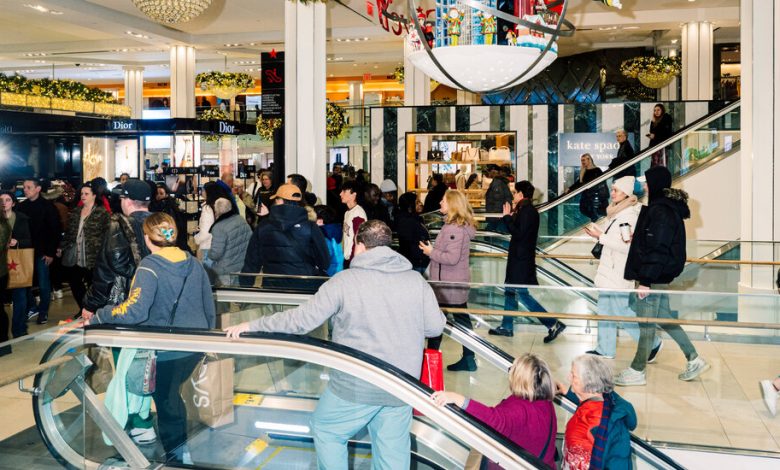This Season’s Hottest Shopping Trend: Falling Prices

American shoppers, burned by more than two years of rapid inflation, are getting some welcome relief this holiday season: Prices on many products are falling.
Toys are almost 3 percent cheaper this Christmas than last, government data shows. Sports equipment is down nearly 2 percent. Bigger-ticket items are also showing price declines: Washing machines cost 12 percent less than a year ago, for example. And eggs, whose meteoric rise in prices last winter became a prime example of the country’s inflation problem, are down 22 percent over the past year.
Consumer prices, in the aggregate, are still rising, though not nearly as quickly as a year ago. Most groceries still cost more than they did a year ago. So do most services, such as restaurant meals, haircuts and trips to the dentist. And housing costs, the biggest monthly expense for most Americans, are still rising for both renters and home buyers. Overall, the price of physical goods is flat over the past year, while the price of services is up a bit more than 5 percent.
Still, economists view the moderation in goods prices as an important step toward putting the high inflation of the past two and a half years more firmly in the rearview mirror. They expect it to continue: Most forecasters say prices for physical products will keep falling next year, especially prices for longer-lasting manufactured goods, where the recent declines have been largest. That should help price increases overall to ease.
“We’re just kind of in the beginning of that phase, and we should continue to see downward pressure on prices in this category,” said Michelle Meyer, chief economist for Mastercard.
For consumers, who have been dour about the economy despite low unemployment, falling prices on many goods could provide a psychological lift. After the rapid inflation of the past few years, a mere slowdown in price increases might not feel like much to celebrate. But seeing prices fall could be a different story — especially because some of the biggest recent declines have been in categories that consumers tend to pay the most attention to, such as gasoline. (The price of regular gas, which topped $5 a gallon nationally in June 2022, has fallen to just over $3 on average, according to AAA.)
“People will key in on certain prices,” said Neale Mahoney, a Stanford University economist who recently left a role in the Biden administration. “We know that people will overweight certain things.”
The price of many goods soared in 2021, fed by a surge in demand from consumers flush with pandemic relief checks and by supply chain disruptions that limited supplies of many products, especially those from overseas.
Many economists initially expected a quick reversal, but instead prices kept rising. Supply chains took longer to return to normal than expected, and Russia’s invasion of Ukraine led to a spike in energy prices in 2022. At the same time, consumer demand for goods remained high, and many companies took advantage of the opportunity to push through price increases and pad their profit margins.
Now, however, many of those forces are beginning to fade. Supply chains have largely returned to normal. Oil prices have fallen. Economic weakness in China and other countries has held down demand for many raw materials, which feeds through to consumer prices.
Softer demand from American consumers could also be playing a role. The Federal Reserve has raised interest rates repeatedly since early last year in an effort to curb spending and control inflation. Consumers have so far proved remarkably resilient, but retailers in recent months have reported that shoppers have increasingly traded down to cheaper items or waited for sales before buying — trends that could accelerate if the economy cools further next year.
“We think that the consumer is going to be looking for value, and that’s because they are very sensitive to price,” Carlos E. Alberini, chief executive of Guess, the fashion retailer, told investors last month. The company has “revisited some of the pricing structure we have in all brands,” he added.
Some toy manufacturers and retailers that sell toys have also said they expect sales this season to be less robust than in years past and have leaned into advertising their products’ affordability.
At many companies, price cuts have taken the form of Black Friday sales and holiday promotions that are larger for some categories of items than in past years. At Signet Jewelers, the big diamond retailer, sales fell in the third quarter, and the company recently said that it expected sales to be lower this holiday season than last year in part because of “elevated promotional activity.”
“It’s been a different holiday season,” Virginia C. Drosos, Signet’s chief executive, told investors on a conference call this month. Instead of shopping early, customers are waiting to make their purchases and are looking for deals, she said.
Matt Pavich, senior director of innovation and strategy for Revionics, a company that uses artificial intelligence to help retailers set prices, said companies were trying to cut prices before their competitors do.
“As prices come down, there’s going to be the race to bring prices down more, get the credit for that,” he said. “We’re going to see retailers really trying to win back consumers’ trust.”
Still, prices for most products remain well above where they were before the pandemic. A dozen eggs cost about 50 cents more than in February 2020. Used car prices, another prominent example of pandemic sticker shock, have fallen more than 10 percent from their peak early last year but are 37 percent above where they were in February 2020.
Services prices are still climbing more quickly than before the pandemic. Some economists say that goods prices will need to fall further for overall inflation to return to the Federal Reserve’s target of 2 percent a year.
“We need pretty substantial deflation, and I wouldn’t call what we’re seeing ‘substantial,’” said Wendy Edelberg, director of the Hamilton Project, an economic policy division of the Brookings Institution. “It’s not even substantial in a historical context.”
Indeed, prices of durable goods fell much of the two decades that preceded the pandemic. Long-term trends such as globalization and automation have tended to push down manufacturing costs. Intense competition among retailers, especially with the rise of online shopping, meant those savings were mostly passed on to consumers.
Services prices, on the other hand, rarely fall, in part because wages account for a much larger share of the cost of most services. During the decade before the pandemic, services prices gradually rose while goods prices were flat or fell, resulting in an extended period of stable, moderate inflation.
Economists don’t expect to see outright deflation, in which prices fall for both goods and services. That’s a good thing: Overall price declines are generally viewed as economically dangerous, if they last.
There are a few reasons. For starters, in theory, deflation could prompt consumers to hold off on spending, touching off a downward spiral. People may be unlikely to buy today what they expect to be cheaper tomorrow. Once deflation takes hold, it can be difficult to escape: Japan has been stuck in a deflationary pattern since the late 1990s.
“When demand in the economy is weak, the last thing you want is someone to say, ‘I’m not going to buy that car today because it’s going to be $600 less expensive in six months,’” said Karen Dynan, an economist at Harvard.
For another, companies are unlikely to raise wages in a world where they cannot charge more. And if wages are not going up — or are even going down — it will be harder for households to keep up with fixed bills, like mortgage interest payments.
But while broad-based price declines are a problem, most economists view the more limited declines happening now as a sign that the economy is gradually moving past the disruptions of the pandemic.
“Supply chains have basically normalized,” said Neil Dutta, head of economic research at Renaissance Macro. “Household demand behavior has basically normalized, the dollar is still pretty strong. I wouldn’t see a reason why goods prices would go higher.”




